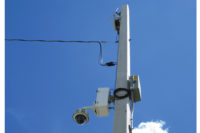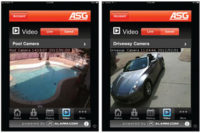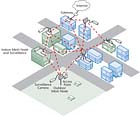
In a mesh network, such as this one, as long as each node can see any other node, data can be passed on around obstacles.
ILLUSTRATION COURTESY OF FIRETIDE
ILLUSTRATION COURTESY OF FIRETIDE
When a video surveillance installation requires one or more cameras to be placed at a substantial distance from the main system, technicians may opt for a wireless solution. “Any time a wired installation would require trenching or there is a great distance involved, wireless will be a fraction of the price,†notes Mark Ellsworth, director of sales and business development for Smarter Security Systems, an Austin, Texas-based manufacturer of wireless video equipment.
What is particularly challenging about wireless video, however, is that a video signal requires significantly more bandwidth than the comparatively simple signals associated with other types of security equipment such as motion detectors or door or window contacts. Until recently, wireless video equipment was required to carry a full composite video signal operating at 30 frames per second and to deliver the same bandwidth as a coaxial cable. Such systems still may be the best option in certain circumstances. But today, the rise of digital surveillance video based on the Internet protocol (IP) has made other choices available that can help minimize the bandwidth required by supporting video compression and adjustable levels of image resolution and frames per second.
In selecting the right wireless video option for a particular application, technicians must choose between analog and IP video, and must consider whether to use a point-to-point, point-to-multipoint or mesh design. Other considerations include the operating frequency and the type of antenna.
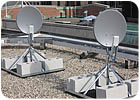
These twin Motorola Canopy 5.7 GHz radios — one providing T1 (1.5 Mbps) service and one providing 3 Mbps bandwidth — are used at a private company. Radios can be configured "over the air" to provision bandwidth upgrades for a customer without an expensive site visit.
PHOTO COURTESY OF COMMUNITY WISP INC.
PHOTO COURTESY OF COMMUNITY WISP INC.
ANALOG OR IP?
If an installation requires just a few cameras, analog wireless video may be the appropriate choice. Typically an installer can use any analog camera, which is connected to a radio that communicates with another radio at or near the video recorder or monitoring station. Line of site between the two radios is a must. This type of installation is calledpoint-to-pointbecause each camera requires a pair of radios and only a single video signal is carried between them. The maximum distance that can be covered using analog video will depend on a variety of factors, including how high the radio is mounted and what type of antenna is used (see “Antenna†section within this article). But in general, distances as great as several miles are possible, particularly if repeaters are used. Another consideration is that, if the analog camera has pan/tilt/zoom functionality, the data stream controlling that functionality must be sent wirelessly to the camera.IP wireless video can use either an analog camera and video recorder with encoders to convert analog signals to IP format or can work with a network video recorder and IP camera that are designed to process signals in IP. In either case, the images from the camera are sent in one of several digital compression formats, which could include MPEG4, JPEG, or wavelet.

A Motorola Canopy 5.7 GHz radio provides T1 (1.5 Mbps) service to a private company.
PHOTO COURTESY OF COMMUNITY WISP INC.
PHOTO COURTESY OF COMMUNITY WISP INC.
The maximum number of cameras that can be used in a point-to-multipoint or mesh design will depend on a number of factors, including image resolution, the compression format used and the frames transmitted per second. Generally installers will use no more than about eight to 10 cameras per channel, but some systems may be able to support multiple channels (usually no more than 15).
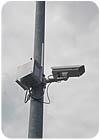
Installed on this street light pole are a Fluidmesh 2200 unit and a Pelco fixed analog camera. Installed inside the enclosure of the Fluidmesh unit is a video server that digitizes and compresses the video coming from the analog camera and streams the video over the wireless network. The Fluidmesh 2200 unit uses 8-10 dBi omni-directional antennas. These types of antennas are particularly appropriate to create mesh networks with wireless units close to each other (up to 2,000 feet of distance). Omni-directional antennas need virtually no alignment and allow the creation of wireless links in every direction (360 degrees around).
PHOTO COURTESY OF FLUIDMESH NETWORKS
PHOTO COURTESY OF FLUIDMESH NETWORKS
One systems integrator who specializes in deploying wireless video for municipal applications says the current generation of standard 802.11 equipment is much more secure than earlier versions. “With older generations of equipment, security was a valid concern,†says Chris Moomey, account manager for Current Technologies Corp., a Naperville, Ill.-based systems integrator. “Manufacturers are now providing management utilities and rotating WEP (wired equivalent privacy) codes. Today’s systems are based more on passcodes that can be changed and monitored as opposed to a static WEP key. The systems also have rogue access point detection and user management so that if you have an unauthorized user, you know about it.â€
Although Current Technologies uses standard 802.11 equipment from Cisco Systems of San Jose, Calif., Proxim Wireless, also of San Jose, and Orthogon Systems based in Waltham, Mass., the company adds software from Milestone Systems, Beaverton, Ore., to customize each installation for video surveillance. The Milestone software enables authorized users to view images from security cameras on their personal computers or personal digital assistants, such as a Palm Pilot.

Honeywell Video's HTRD400 series Mobile Digital Data Recorder captures sharp, crisp images and clear audio, including four channels of video/audio and stores up to 80GB.
PHOTO COURTESY OF HONEYWELL VIDEO
PHOTO COURTESY OF HONEYWELL VIDEO
Using a mesh design also can increase range, with some manufacturers claiming coverage as great as 15 miles or more from their proprietary mesh offerings.
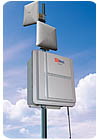
Trango Broadband Wireless offers its HD Mesh system, which provides an innovative, self-healing, high-speed backbone ring. The system incorporates multiple frequency bands, including the 4.9 GHz licensed band for safety personnel, first responders and homeland security applications. HD Mesh wireless backbone radios are available in 4.9, 5.3, 5.4 and 5.8 GHz frequency bands.
PHOTO COURTESY OF TRANGO BROADBAND WIRELESS
PHOTO COURTESY OF TRANGO BROADBAND WIRELESS
FREQUENCY AND ANTENNA TYPE
Another choice that an installing company must make when designing a wireless video system is the transmission frequency. These include licensed frequencies, such as 4.9 GHz, which is reserved for public safety use, and unlicensed frequencies, including 900 MHz, 2.4 GHz, 5.3 GHz, and 5.8 GHz. As Ray Sewell, video product sales manager for equipment manufacturer Trango Broadband Wireless of San Diego explains it, “The higher the frequency, the shorter the wave gets and the harder it becomes to penetrate objects.â€That means systems operating in the 900 MHz or 2.4 GHz range may work best when there are small obstacles blocking the path to a camera. The downside to using the 2.4 GHz band, however, is that the 2.4 GHz frequency range is used for many other types of equipment, including wireless local area networks and microwave ovens, so interference can be an issue. Also, 900 MHz and 2.4 GHz solutions typically offer less bandwidth than 5.3 GHz or 5.8 GHz solutions, which means that the higher frequency offerings may be a better choice when small obstructions are not a problem. Some wireless video manufacturers offer devices with radios that operate at more than one frequency and self-select the best frequency based on operating conditions.
Baton Rouge, La.-based systems integrator Vanguard Technologies Inc. frequently installs wireless IP video, using equipment from Trango, Redline Communications, Axxcellera and Proxim. Noting that each manufacturer’s offering is a little different, Vanguard president Jerry Jones says the specific equipment chosen for an installation depends on the number of cameras to be supported, the range required and the customer’s budget. But whatever the application, Jones favors radios that operate over a wide frequency band with multiple channel options. That approach, he says, “gives us the full flexibility to manage and to with ease co-exist with other networks that may be in the area.â€
The final choice that a security company must make in planning a wireless video installation is the antenna, which also affects the range that a wireless video solution can provide. For example, 360-degree antennas, which send a signal equally in all directions, are the easiest to install because they do not require precise aiming and may be the best solution when the camera is located at a distance of a few thousand feet or less. If maximum range is desired, however, installers will want to use a focused antenna that transmits the signal within a narrower angle of coverage.
Sidebar: 6 Tips for Planning a Wireless Video System
- “The largest consideration is the link budget,†advises Tom Woods, director of operations for Community WISP Inc. of Waltham, Mass., a company that specializes in installing large IP wireless video networks based on Motorola’s Canopy system for security companies. To calculate the link budget, Woods says, installing companies must consider where the DVR and monitoring station are located on the network, along with the bandwidth required per camera. A recent Community WISP installation included five cameras in a point-to-multipoint design.
- To ensure maximum security when using an 802.11-based IP solution, look for a system based on a rotating encryption key, notes Peter Boriskin, director of product management for access control for San Diego-based security equipment manufacturer American Dynamics. “A longer key is more difficult to crack and the more times you use the same key, the more vulnerable it gets,†he adds. “Pay attention to how many times a key is used and use a long key chain.â€
- Manufacturers often may be willing to help installing companies with their designs, notes Umberto Malesci, president and co-founder of Boston-based Fluidmesh Networks, which offers a proprietary Ethernet-based wireless solution which he says is optimized for use with surveillance video. “Show the design to the manufacturer and ask if it makes sense,†Malesci says.
- A spectrum analyzer can be useful in determining the amount of RF noise at an installation — and topographic maps can help in determining how high an antenna needs to be.
- The higher the frequency used, the less ability a wireless system will have to penetrate objects. If obstructions are large, a mesh network may be the best alternative. In a mesh network “as long as each node can see any other node, data can be passed on around obstacles,†explains Mike Downs, vice president of marketing communications for Firetide, a Los Gatos, Calif.-based mesh equipment supplier.
- Consider using half-duplex transmission schemes, which can transmit in either direction but only one direction at a time, advises Jerry Jones, president of Baton Rouge, La.-based systems integrator Vanguard Technologies Inc. Full-duplex systems require two channels, while half-duplex systems only require one, explains Jones — and that reality gave half-duplex systems an edge during the emergency situation created in his area after Hurricane Katrina. So many people were using radio devices at that time that there was a high level of RF interference — and it was easier to find just a single clear channel, rather than two, he says.
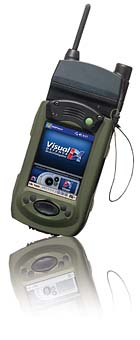
Handheld unit by Visual Defence Inc.
PHOTO COURTESY OF VISUAL DEFENCE INC.
PHOTO COURTESY OF VISUAL DEFENCE INC.
Sidebar: Wireless Applications ‘on the Fly’
Although the most common use of wireless video in surveillance applications is to connect remote cameras, wireless can enable some other capabilities, as well.For example, some school buses are now equipped with wireless video systems that include a camera and a tamper-proof DVR, notes Larry Chin, product manager for Honeywell Video Systems of Louisville, Ky., manufacturer of one such system. When the bus pulls into the parking lot at the end of the day, the video signals can be automatically downloaded to the school district’s security department. Alternatively, security personnel can scan the video to help ensure that no incidents of concern have occurred.

The VD Eye platform from Visual Defence Inc. is designed to support multiple architectures, as the system must communicate with new and legacy platforms for the device, the communications system, and the management system.
PHOTO COURTESY OF VISUAL DEFENCE INC.
PHOTO COURTESY OF VISUAL DEFENCE INC.
